Contacts
 |
Overview
Environmental Overview
LANL is a complex site, environmentally speaking. With over 37 square miles of complex geology and hydrogeology, 2,000 feet of elevation change, and an average rainfall of less than 12 to 16 inches per year, it is home to 14 major canyon systems and thus has a large impact on the Rio Grande. Ecosystems within the site range from riparian to high desert and boast over 2,000 archaeological sites, as well as endangered species habitat.
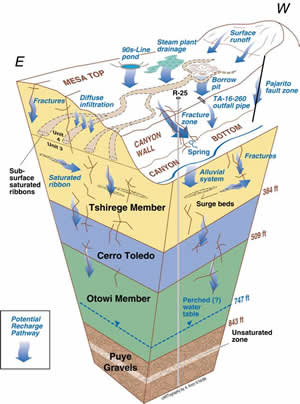
The complexity and size of LANL operations make environmental compliance a continuing challenge. Legacy contamination—both chemical and radioactive—exists at many locations and is being addressed by remediation efforts under the NMED Consent Order. Remediation is scheduled for completion in 2015.
Current LANL activities have a measurable impact on air quality but generally only rise to a small fraction of applicable environmental standards and have no significant impact on public health.
We have completed most actions in characterizing groundwater hydrogeology and are currently working to determine the best possible long-term monitoring network. In the groundwater, we have found one contaminant, hexavalent chromium, above regulatory levels; and one, perchlorate, above recommended levels. We are taking actions to prevent any potential effects on human health and the environment. No contaminants have been found in drinking water supplies above regulatory levels. We are working to meet newly imposed surface water effluent limits.
Systems for risk reduction such as the Environmental Management System, New Project Review, and pollution prevention are important to further reduce LANL impacts.
Legacy
Legacy Contamination
Activities at LANL have created byproduct wastes since the 1940s. Historic practices for disposing wastes, although generally accepted at the time, are not in keeping with today's standards. As a result, there are numerous environmental management challenges at LANL today. The distribution and migration of legacy contaminants are influenced by historic releases, current operations, and natural processes. While many legacy contaminant sources have been removed, residual contamination remains in canyon systems, such as soil sediments, vadose zone (unsaturated layer), and shallow and intermediate groundwater.
Topography
- The surface topography of the LANL site naturally favors migration. Additionally, subsurface hydrogeology presents complicated characterization and remediation problems.
Contaminant Sources
- Sources of contamination can be divided into two categories:
- Point Sources
- Historic facilities and storage areas (i.e., underground piping, outfalls, sumps, slabs)
- Experimental sites
- Material Disposal Areas (landfills);
some now Nuclear Environmental Sites
- Some historic sites that are still operational
(i.e., firing sites)
- Diffuse Sources
- canyon sediments
- surface water
- groundwater (vadose zone, shallow and intermediate aquifers)
Legacy Effects on Water
- Impacts to surface water include the fact that contaminants originated from past outfalls and waste disposal sites. Additionally, water from natural and industrial sources causes resuspension of contaminants from legacy sites and canyon watercourses. As far as groundwater is concerned, large-volume liquid releases from past outfalls moved contamination through ground layers. Multiple treatment facilities and outfalls have been required across the Laboratory due to dispersed locations of Technical Areas and natural canyon features.
Historical Water Management Practices
- During the 1940s and 1950s, untreated radioactive liquids were discharged from the “acid sewer” to Acid Canyon and transported to Pueblo and Los Alamos canyons. Treatment of sanitary and laundry wastewater included discharge to septic tanks with overflows to canyons. Because of this, RAD treatment facilities were constructed to serve TA-1, TA-3, and TA-21. In 1963, the TA-50 Radioactive Liquid Waste Treatment Facility started operations. By 1978, the NPDES Permit included 120 Industrial and 12 Sanitary Outfalls.
Status
Environmental Status
How are we doing? Select a topic from the list below to see our current status.
All-Pathway Radiological Dose Assessment
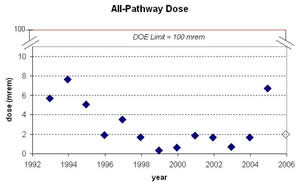 - The majority of potential offsite dose calculated is from stack emissions at LANSCE with negligible contributions from direct radiation, water, or foodstuffs.
- DOE regulates the all-pathway dose, combining air emissions with direct radiation, ingestion, inhalation, and other exposure paths.
- DOE limit is 100 millirem/year.
- Theoretical maximally exposed offsite individual (MEI) dose is ~6.7 millirem (same as stack dose).
- Typical background radiation levels in northern New Mexico are 350 to 400 millirem.
- Average Resident Dose
- Los Alamos = 0.10 millirem
- White Rock = 0.06 millirem
- Santa Fe less than 0.01 millirem
- Espanola less than 0.01 millirem
Checking Contamination in Canyons
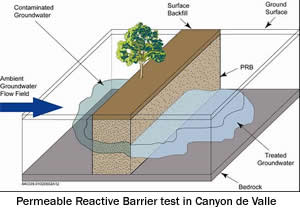 - Canyons: Extensive characterization, monitoring, and risk assessment continues.
- Groundwater: Extensive characterization, monitoring, and risk assessment continues. We are developing innovative approaches to modeling and remediation. Characterization efforts are revealing previously undiscovered contamination issues. Canyons are the major pathways for contamination.
Hazardous Waste Status
- Thousands of waste generators.
- 87 hazardous & mixed waste TSDs in 8 Technical Areas.
- 533 hazardous waste generator sites.
- 31 New Mexico Special Solid Waste generator sites.
- 1 Solid waste disposal facility in post-closure.
- Toxic Substance Control Act (TSCA) authorization for onsite PCB disposal.
- 14 TSCA/PCB waste storage areas.
- Removed regulated underground storage tanks.
- Compliance performance inadequate.
- Resource Conservation and Recovery Act (RCRA) Corrective Action currently dominated by Consent Order for legacy sites.
Legacy Waste Status
 - Scheduled to complete all site remediation by 2015
- We are in full compliance with the New Mexico Environment Department (NMED) Consent Order
- We have met all deliverables on time or early
- We are in full compliance with Solid Waste Management Unit component of Federal Facilities Compliance Agreement with EPA
- We successfully integrated accelerated remediation actions with operations
Non-radioactive Emissions (NMED)
 - All emissions are well below permitted levels and EPA & NMED limits
- Semi-annual internal assessments have revealed no significant issues
- NMED performs periodic external assessments
Radioactive Air Emissions (EPA)
 - All emissions are below EPA limits.
- 28 stacks continuously monitored.
- Approximately 80 total sources tracked.
- EPA limit: 10 millirem per year to maximally exposed off-site individual (MEI).
- The primary source of emissions is radioactive gases from the LANSCE facility.
- In 2005, levels exceeded the projected level due to elevated levels resulting from failure of an emissions controls system. The problem was fixed in November 2005.
- In 2006, the projected level will again be 1 to 2 millirems.
Progress on Clean Up of Soil
 - Successfully identified, characterized, and removed many contaminated sites.
- 1,369 of identified 2,124 Solid Waste Management Units have been remediated.
- Removed over 80,000 cubic yards of contaminated materials from the Laboratory environment.
- Accelerated Corrective Actions integrate with current operations by reducing risk to workers and reducing risk of spreading contamination.
- Many contaminant source terms have been removed.
- Residual contamination remains in vadose zones and canyon system sediments.
Water Quality Status
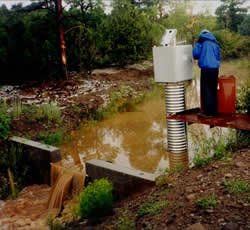 - Effluent discharges from outfalls will not meet new NPDES Permit requirements for certain metals (Al, Zn, Cu, As) and PCBs.
- Runoff from storm events in canyons does not meet new NM stream standards.
- Non-reactive contaminants (nitrate, perchorate, tritium, chromium, high explosives, chlorinated solvents) from past discharges have migrated to deeper groundwater.
- Reactive contaminants (plutonium) bond near the surface.
- Chromium in the regional aquifer beneath Mortandad Canyon is four times the EPA drinking water standard. Current hypothesis: released into Sandia Canyon from 1950 to 1971 as a part of the power plant cooling tower discharge.
- Study of radionuclides, PCBs, and metals in fish found no difference between upstream and downstream levels, and PCBs and metals are above “chronic intake” thresholds up and downstream.
Operations
Environmental Operations
Read about some ways in which LANL is protecting the environment through effective environmental management.
Applied Forestry & Wildfire Mitigation
- Fuels
- Overstory fuels reduced by thinning, fire, and tree mortality
- Understory fuels - especially grass - have increased
- Drought
- Threat during this summer will be the most severe on record
- Pinon mortality has changed complexity of fuel distribution
- Preparations for a Severe Fire Season
- upgrading fire roads and fire breaks
- dip tanks and fire suppression facilities
- fire response center at TA-49
- maintaining emergency response capabilities at the Emergency Operations Center
Protecting Biological Resources
- The Biological Resources Compliance and Monitoring Team's primary responsibilities are management of threatened and endangered species and their habitats and protection of floodplains, wetlands, migratory birds, and other protected species and habitats.
- We support LANL by:
- Reviewing potentially applicable laws, regulations, DOE Orders, NEPA findings, and LANL policies related to biological resources and updating compliance requirements for LANL
- Identifying compliance requirements related to biological resources for projects as part of project reviews
- Documenting and communicating regulatory assessments
- Preparing compliance documents, as needed
- Negotiating and implementing agreements, such as Management Plans, with regulators to meet compliance requirements
- Conducting biological monitoring or research projects, as needed
Tracking trends in wildlife populations and human-wildlife encounters
Managing Cultural Resources
- LANL has over 2000 archaeological sites and 500 historic buildings.
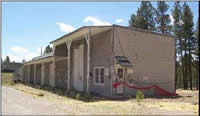
- 20 to 30 small archaeological annual project surveys
- 40 archaeological sites excavated for Land Conveyance and Transfer Project
- 75 to 100 historic building assessments annually
- Native American consultation -- Cultural Affiliation, Traditional Cultural Property, Native American Graves Protection and Repatriation Acts
- 800 to 1000 resource protection reviews annually
- Locations of Archaeological Sites
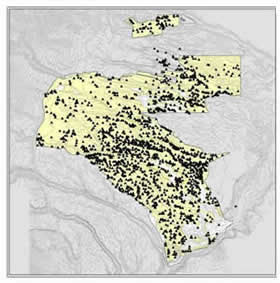
Hazardous Waste Successes
- TA-46 Sanitary Wastewater Treatment Plant
- Substantial improvement in compliance performance during last two years
- Improving relationship with regulators
- Substantial reduction in hazardous waste generation over last several years
- Significant improvement in lab processes and integration through the EMS
- General agreement to cease onsite disposal of PCBs
- Initiative to reduce the number of regulated units
Risk Reduction Spans Mission Life-cycle
- Early attention to environmental requirements pays long-term dividends on corrective actions that may impact mission scope, schedule, and cost.
 |
 |
 |
 |
 |
- Environmental Management System
- Project Requirements Identification System
- Job Hazard Analysis
- Pollution Prevention Assessments
|
- Integrated Project Teams
- Air Permitting
- Water Permitting
- RCRA Permitting
- NEPA Permitting
|
- Compliance Assurance
- Inspections (all media)
- Performance Reporting
|
- Natural Resource Monitoring
- Cultural Resource Monitoring
- Biological Resources Monitoring
|
- Environmental Restoration
- D & D
- Long-term Stewardship
- Legacy Equipment
|
Extensive Water Monitoring
- NMED Consent Order - Groundwater
- Approximately 150 Groundwater Wells
- Approximately 50 Surface Water Sites
- FFCA - Storm Water
- 60 Watershed Gaging Stations
- Approximately 300 Solid Waste Management Units
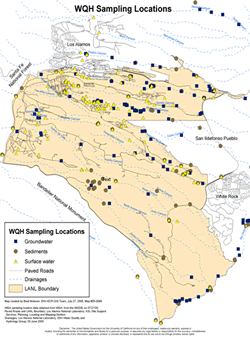
Reduced Water Releases to Environment
- TA-46 Sanitary Wastewater Treatment Plant
- Reduced outfalls from 141 to 16 since 1993
- Reduced total flows by approx. 80% since 1994 (1300 to 230 million gallons per year)
- Improved effluent quality with one exceedance in 2005
- "Clean" effluent still drives migration and build-up of residual contaminants
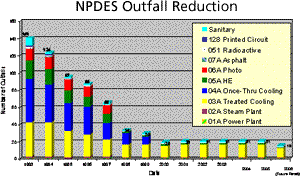
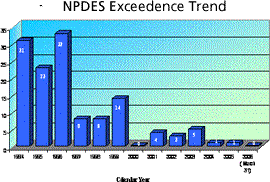
Improvement in Water Treatment
- TA-46 Sanitary Wastewater Treatment Plant
- 1992 - Eliminated 10 Sanitary Facilities/Outfalls
- TA-50 Radioactive Liquid Waste Treatment Facility Upgrades (Contaminants Reduced)
- 1999 - Reverse Osmosis and Ultrafiltration (Radionuclides except Tritium)
- 1999 - Reverse Osmosis and Waste Acceptance Criteria (Nitrate)
- 2000 - Waste Segregation and Evaporation (Tritium)
- 2002 - Ion Exchange (Perchlorate)
- TA-16 High Explosives (HE) Wastewater Treatment Facility
- 1998 - Eliminated 9 HE Facilities/Outfalls
- 2003 - Ion Exchange Upgrade (Perchlorate)
 |

 Environment
Environment

